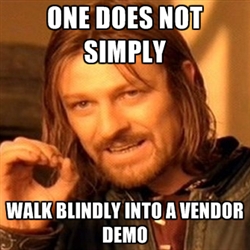3 Incredibly Important Steps to Consider When Selecting a CMS Platform
During the CMS selection process, there are of course dozens of considerations in play when taking on such a behemoth task. Any part of the process can occupy varying amounts of time and personnel. With that in mind, I wanted to grab a few of my top shelf ‘requirements gathering’ strategies which I feel are paramount to taking this gigantic step into a business’ digital evolution. This list is by no means complete, and probably not shared by everyone. Such is the fickle world of Selecting a Web CMS Platform.
In the middle of December we will be airing our year end episode of CMS Connected covering everyone’s favorite subject: How to Select a Web CMS (platform). We are incredibly stoked and have been preparing for ages. However, I wanted to stimulate some interest and possible dialogue with a little bit of editorial content.
Talk to Everyone
 I mean it. Everyone! If you don’t involve the ‘whole’ of your stakeholder pool, your project will fail. Full stop! Similarly, as you would research visitor behavior and experience feedback before building a website. You must cast a wide net out across your ‘potential editor landscape;’ notice how I said ‘potential editor’? There are content champions in all areas of an organization but until you ask them, you’ll never know. Break apart any hierarchy, toss your ego, and really let them know they are being heard and that their feedback is invaluable (which it is).
I mean it. Everyone! If you don’t involve the ‘whole’ of your stakeholder pool, your project will fail. Full stop! Similarly, as you would research visitor behavior and experience feedback before building a website. You must cast a wide net out across your ‘potential editor landscape;’ notice how I said ‘potential editor’? There are content champions in all areas of an organization but until you ask them, you’ll never know. Break apart any hierarchy, toss your ego, and really let them know they are being heard and that their feedback is invaluable (which it is).
Back in our first video, our guest Carmine Porco discussed the need to develop detailed requirements. A major part of this is essentially letting your staff help dictate some of the user case scenarios. If you don’t talk to your editors, you will not know what they need. Don’t assume you do, or risk a swift dose of ‘Fail’.
For instance, have you thought about (your list will likely cover hundreds of feature considerations):
- Do you have an interest in building new channels of traffic to the website from Search and Social? If you answered yes, then a fresh content strategy is a must and the more diversity you have amongst your authors, the more authority you can develop for your blog content and articles. You may even uncover blog influencers in your staff who may be thrilled to supply some editorial content to the corporate blog.
- Are you considering an intranet/extranet? Is developing an ‘Organizational Family/Community’ part of the new mandate which looks to connect national and international branches or offices? Does your staff show an interest; what specifically is it about an intranet that interests them, inquire across the various offices, etc…? There may be a cultural divide that can bring new insights into sharing behavior and social trends. This inclusion may uncover a whole new staff dynamic that was always there and can now flourish in a new enterprise Social Intranet platform, thus moving some software solutions to the forefront of your selection process. With this new knowledge you can incorporate a whole new vision into your content development and marketing strategy.
- Does the company require sophisticated eCommerce features with payment gateway integration? What level of personalization will the team wish to develop. Are there ‘local search’ considerations and retail spaces that can be promoted based on demographic information shared by Social Network API’s, etc…
- Do you have a Digital Content Marketing division for Search and Social Media? They will no doubt have specific tools in play that are of immense value to them, ask them to demo the digital marketing features, invite them into the vendor demos, and ask them to develop ‘personas.’ These people are your traffic development heros, heed their advice.
- Ask your marketing team what specific features they feel are key to the success of their specific position both from a public side (tracking user behavior/conversions) to an intranet side (centralized document management, collaboration and workflow). If you find staff with little understanding of CMS, setup a learning session. You need feedback from the simplest user to the super user alike!
- Take your time … Talk to everyone; you might be surprised what you uncover. Yes, you may also find your licensing costs just tripled. Time to bring in that all star PM and develop a phased rollout strategy. :)
Don’t Let IT Dictate the Selection Process
This idea might be a little more controversial, but it comes from experience. Previously, Scott Liewehr brought up the need to reach out to the IT department when collecting all this early requirements data. Absolutely! It’s going to be your IT group that has to learn how to build the system, develop any customized features, and support it for the lifetime of the product. You sure as heck better involve those guys and gals; they keep the whole technological machine running in your company.
However, what you can’t allow is for IT to have any sort of ‘veto’ on the final process on the CMS selection. Our panel was pretty unanimous when asked what the leading cause of selecting the wrong CMS was; the unfortunate and sometimes unbalanced conflict between IT and Marketing. Why? IT is not the intended end user. Finished...
We have heard countless horror stories of companies who have run fantastic internal stakeholder exercises and developed a clear path to a winning shortlist of vendors, only to have the CTO step all over their fact finding process. We have never really understood this since the IT team is not the target audience, nor the user group. Remember, that while their immense knowledge and technical superiority are necessary for deployment, it is not required in order to establish the functional requirements for the administrative and editorial teams. The website is essentially a marketing tool. That should help lead any conflict to a diplomatic result.
Your CMS platform decision needs to be determined based on countless interviews from your content and editorial team, coupled by the long term marketing strategies as presented by the marketing group.
Take Control of the Vendor Demos
Vendors desperately want to demo their products. It’s a chiseled and rehearsed process designed to knock your socks off and lull you into a state of amazed complacency. Okay, that’s probably stretching it a bit. Generally, if they are demonstrating their product for you, it’s because they’ve been invited by your group as part of a shortlist process. Throughout the RFP process these vendors have been able to demonstrate their professionalism and ability to speak to your needs. However, don’t let the vendor drive the agenda for the demonstration.
Consider that licensing can easily reach into the high 5 digits and beyond, they work for you; and so you and your team should be dictating exactly what is expected on ‘game day.’ Be fair and provide plenty of notice as to the specifics of your expectations. Bring a cross section of ‘prospective editors’ to the demo as well. Your super user will have completely different feedback than your entry level editor. Both of which will be invaluable to the products ability to be accessible across diverse editor roles.
“Personas, personas, personas!” this was Irena Guseva’s mantra back in the last selection video and it makes complete and total sense. Jumping off topic quickly; remember that this list is by no means chronological, there are often many more meetings and vendor conversations that happen before the demo stage. Usually an entire RFP process has taken place prior to the Vendor shortlist which precedes the demos.
Provide several personas to the vendors to demo for you during this last exercise. Again (I can’t stress this enough), be diverse in your feasibility tests. Here are few extremely brief personas to get the ideas flowing.
Base your personas on real people who are literally IN the room with you during the demo.
- Kermit, who doesn’t necessarily provide a lot of site content but is quite social and provides great value via theIntranet connecting with other associates (locally and abroad). She has taken to using the document sharing and collaboration features for project documents.
- Fozzie provides a lot of high value site content and has grown into a real thought leader in the company has integrated profile features connecting his Google +, Linkedin and Twitter profile information. He needs to see the whole blog post creation cycle on the public site, complete with social network sharing features and customizations. Billy can also determine what content he shares across the intranet and can turn off network sharing of his external profiles.
- Gonzo manages the social media traffic and sharing features across the site. He is very analytical and requires a high level of tracking in order to measure the effectiveness of his various social campaigns. With the help of his team he sets up campaign landing pages with unique URL’s and needs to be able to post simultaneously to Twitter, Google+, Linkedin, Facebook and Pinterest. URL shortening is key and so is tracking of specific campaigns. Big bird, Gonzo’s marketing supervisor, needs to approve the campaigns prior to release by way of simple workflow. The whole team needs to see the campaign in action and must be able to watch users as they navigate the site. Detailed reporting is also a top shelf requirement for his campaigns.
- Rizzo works on the commerce side of things and needs to work on personalization for visiting users. Rizzo needs to collect regional information based on Facebook or Google Connect features so that they can display personalized results and ad copy based on location, age, gender or any number of fields that is shared via the API’s. The team needs to see a complete cycle of personalization from the demo since their needs are great based on the company’s goals for extending their commerce capabilities.
Really, go to town on the personas since your next step could very well be cutting a cheque for $50,000 (software license only) to start! Don’t hold back and see how the representative and the software hold up to pressure. Follow up with your team one on one after the demos; this is their chance to be a part of the decision process. Lastly, be sure to thank every human involved in the process. From IT to secretary and everyone in between. If the requirements gathering was as inclusive as it should have been, this thank you list will be big. :)
Good luck and see you at the show!Author - Jade Carter

Jade Carter
Jade is a content writer for CMS-Connected, facilitating the needs of the company blog. Bringing 10 years of Search and Digital Marketing to the table, he strives to build informative, relevant and fun editorial posts for the blog feed. Jade is an ultra distance (26.2 miles+) trail runner and lives to run trails in and around his home town of Victoria, BC.